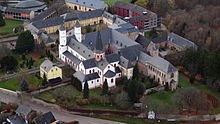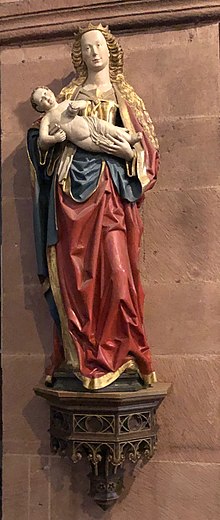Steinfeld Monastery
Steinfeld Monastery in the Eifel is a former Premonstratensian abbey with an important basilica from the early 12th century. Visible from afar, on a hill in the south of the North Rhine-Westphalian municipality of Kall , the "Eifelkloster" forms the Steinfeld district with a few surrounding houses .
The monastery complex has been owned by the Salvatorian Order since 1923 .
history
Although the beginnings of the monastery go back to around 920, the first monastic settlement took place in Steinfeld in 1070. In 1130 it was taken over by the Premonstratensians . The monastery became an important ecclesiastical center in the German Empire and had numerous subsidiaries in Europe, for example the Strahov Monastery in Prague . In 1184 the Steinfeld monastery received the status of an abbey. The abbey had a courtyard in Cologne, the Steinfelder Hof near the church of St. Gereon in the west of Cologne. The Collegium Norbertinum was founded here in 1615 by the abbot Christophorus Pilckmann , which served as the preparation and residence of the members of the order when they studied at the old Cologne University .
In 1200 was at the request of Count Heinrich III. von Sayn formed a new convent under Abbot Erenfried according to the rules of the Premonstratensian order and sent it to the newly founded Sayn monastery . The continuous series of 44 abbots was not ended until 1802 by the secularization . After that, the complex served various secular purposes, the basilica was still used as a parish church . Today the parish of St. Potentinus and several other parishes form the community of the parishes of St. Hermann-Josef Steinfeld in the diocese of Aachen . The complex was taken over as a monastery by the Salvatorians in 1923, who maintained the Hermann-Josef-Kolleg Steinfeld , a grammar school as well as the private art academy Kloster Steinfeld and the Franziskus-Jordan -Gästehaus . After the order wanted to close the boarding school at the end of the 2011/2012 school year, this could be averted by a parents' initiative. But the remaining 15 students were not enough, and the boarding school was finally closed at the end of the 2012/2013 school year. A guest house has been operated in the former boarding school since 2015.
Monastery chief
The following list refers to the series praepositorum et abbatum Steinfeldensium:
|
Toast
Abbots
|
|
basilica
The basilica attached to the monastery was built by the Premonstratensians between 1142 and 1150 as one of the earliest German vaulted churches . It is dedicated to St. Potentinus and his two sons Felicius and Simplicius, whose 13th century shrine is now kept in the Louvre in Paris . Today the building includes parts of several art movements, from the original Romanesque style to Gothic , Renaissance and Baroque to modern steel applications. The basilica has a total of eight bays and six chapels , including the Stephanus chapel and the Ursulakapelle. The basilica also contains the famous König organ and the remains of Hermann Joseph von Steinfeld, who was revered as a saint. The church received the rank of papal minor basilica in 1960.
Hermann Joseph grave
The grave of Hermann Joseph von Steinfeld , placed in the middle of the church and covered by a plate made in 1732 with a reclining figure made of alabaster , makes the church a place of pilgrimage . The actual tomb made of Urft marble dates from 1701. Traditionally, there are always a few fresh apples on the grave next to the alabaster figure. According to legend Hermann Joseph shall once the baby Jesus to the Virgin Mary in the church of St. Mary in the Capitol have offered an apple to Cologne, which it had adopted.
Koenig organ
As early as the 16th century, the Steinfeld basilica had either a swallow's nest organ on the north nave wall or a rood screen organ. In 1509 the rood screen was moved from the third yoke to the church's entrance yoke, where the first large organ was built around 1600 - probably by Floris Hoque from Brabant . For this organ, a new eight-legged main body was built in 1678 in Baroque decor. After 1720 it was supplemented by a positive case and two pedal towers in the gallery parapet. The organ was completed in 1727 by Balthasar König from Bad Münstereifel . König used the old pipe stocks (17 registers) for this. The result was an organ with 29 registers.
The organ was modernized (expansion to 46 registers, electrification of the playing and stop action) in 1934. In 1977 it was shut down due to malfunctions. After extensive research, it was extensively restored in 1981 in the originally baroque style by the organ building company Weimbs from Hellenthal , so that As far as playing technique and sound are concerned, it is now largely in the same condition as in 1727. It comprises 1956 pipes, 35 sounding stops and a mechanical game and stop action mechanism. Most of the pipework is original. Casting cloth traces can still be seen on the oldest pipes. It is one of the most important organs of the Rhenish Baroque .
|
|
|
|
|||||||||||||||||||||||||||||||||||||||||||||||||||||||||||||||||||||||||||||||||||||||||||||||||||||||||||||||||||||||||
- Coupling : II / I, I / P, II / P
- Secondary register: nightingale
Bells
In 1956 the well-known Otto bell foundry from Bremen-Hemelingen cast four bronze bells with the following series of strikes: d '- e' - f sharp '–g'. The bells have the following diameters: 1443 mm, 1285 mm, 1145 mm, 1081 mm. The bells weigh 1950 kg, 1400 kg, 1000 kg, 800 kg.
Further equipment
The originally Romanesque cloister behind the monastery gate was replaced by one in Gothic style between 1492 and 1517. The ornate glass windows of the Ganges (made between 1526 and 1557) were sold to England via Cologne after the secularization . There some were built into village churches and private chapels, such as those of Earl Brownlow in Ashridge Park . Montague Rhodes James , who cataloged the stained glass windows at the beginning of the 20th century, was inspired to write his ghost story The Treasure of Abbott Thomas , the plot of which takes place in part in a Steinfeld (imagined by James). A representation of the Queen of Sheba before Solomon ended up in the Church of St. Mary the Virgin in Depden, Suffolk. The majority of the stained glass windows are now in the Victoria and Albert Museum , including the stained glass window of Christ's Resurrection and the depiction of Christ on the cross . Only two discs came back to Steinfeld.
Numerous wall paintings still visible date from the Middle Ages. The oldest is the depiction of Christ as judge of the world in the Ursulakapelle from approx. 1170. A depiction of Saint Potentinus and one of the Mother of God with child were created around 1325. The Gothic mural in the right transept was painted around 1340.
The Pieta in the north aisle, very close to the entrance, was carved out of tuff in 1420. Three large carved figures (St. Potentinus, St. Hermann Josef and Mary with child) date from the end of the 15th century. Mary is unmistakably made in the “soft style”, Potentinus is depicted as the “Aquitaine Duke” and Herman Josef is shown with the priest's chalice in his hand.
The crucifixion group with Mary and John in the vestibule was originally above the rood screen. Stylistically it can be assigned to Master Tilmann of Cologne and shows clear similarity to the crucifixion group in St. Severin in Hermühlheim .
Steinfelder Missal
A missal written in Steinfeld around 1180 is now in the Getty Museum (Ms Ludwig V4) after it was sold in the 19th century and several stopovers, including the library of William Morris and the collection of Peter Ludwig .
Steinfeld in literature
The secularized Steinfeld Monastery is the setting for the horror story "The Treasure of Abbot Thomas" by Montague Rhodes James , in which an English scholar is guided through an enigmatic church window of the monastery that has been brought to Norwich on the trail of a treasure and its supernatural guardian.
Picture gallery
literature
- Ernst Wackenroder : The art monuments of the Schleiden district . Düsseldorf 1932.
- Friedrich Wilhelm Oedinger: Steinfeld. To found the first monastery. In: Oedinger: From life on the Lower Rhine. Essays from the area of the old Archdiocese of Cologne. Düsseldorf 1973.
- Heinrich Schmidt: Steinfeld. The former Premonstratensian Abbey. Ratingen 1951.
- E. Hegel, Karl Koch: The vita of the Premonstratensian Hermann Joseph von Steinfeld. Cologne 1958.
- Ingrid Joester: Premonstratensian in the Eifel. In: Johannes Mötsch and Martin Schoebel : (Eds.): Eiflia sacra. Studies on a monastery landscape. Mainz 1994.
- Ingrid Joester (arrangement): Document book of the Steinfeld Abbey. Bonn 1976.
- Manfred Gehrke ( edit. ): Conventual directory of Steinfeld Abbey 1549–1802. Kall 2002.
- Salvatorian Monastery Steinfeld (Ed.): 75 years Salvatorian in the Steinfeld Monastery. Festschrift 1998. Kall 1998.
- Nikolaus Reinartz : The old glass paintings in the cloister of the Steinfeld Abbey in the Eifel. A story of discovery . In: Eifelvereinsblatt . No. 12 , 1910, pp. 311-314 ( online [accessed June 24, 2016]).
- Bernward Meisterjahn: Steinfeld Monastery (= Peda art guide. No. 309). Kunstverlag Peda, Passau 1995, ISBN 978-3-930102-66-2 .
- Helmut J. Kirvel: Salvatorian Monastery Steinfeld, Schnell Art Guide No. 1440, 9th edition, Verlag Schnell & Steiner, Regensburg, 2019 ISBN 978-3-7954-5152-3
Web links
- kloster-steinfeld.de - Official website of the Steinfeld Monastery
- Entry on the homepage of the community of parishes Hl. Hermann-Josef Steinfeld
- eifel.de / ... - Brief overview
- architekt-staerk.de / ... - Interactive 360-degree panorama of the inner courtyard
- volksbund.de / ... - Steinfeld Monastery War Cemetery
Individual evidence
- ↑ Joachim J. Half Can: The older Counts of Sayn. 1997, Chapter B.III.2.
- ↑ Claudia Schweda: The Steinfeld Monastery will give up the order. In: Aachener Zeitung. September 27, 2013, accessed June 24, 2016 .
- ↑ Steinfeld Monastery. (PDF; 4.3 MB) Kloster Steinfeld GmbH & Co. KG, February 15, 2018, accessed on June 29, 2018 (brochure).
- ↑ Main State Archive Düsseldorf, inventory of Steinfeld Monastery, files 178
- ↑ More information about the König organ ( memento of the original from May 29, 2014 in the Internet Archive ) Info: The archive link was automatically inserted and not yet checked. Please check the original and archive link according to the instructions and then remove this notice.
- ^ Gerhard Reinhold: Otto Glocken - family and company history of the bell foundry dynasty Otto . Self-published, Essen 2019, ISBN 978-3-00-063109-2 , p. 588, here in particular 554 .
- ↑ Gerhard Reinhold: Church bells - Christian world cultural heritage, illustrated using the example of the bell founder Otto, Hemelingen / Bremen . Nijmegen / NL 2019, p. 556, here in particular 509 , urn : nbn: nl: ui: 22-2066 / 204770 (PhD thesis at Radboud University Nijmegen).
- ↑ The abbot is haunted in Saint Cecilia
- ↑ The Library of William Morris: Steinfeld Missal , accessed October 5, 2017
- ↑ Missal , accessed October 5, 2017
Coordinates: 50 ° 30 ′ 9 ″ N , 6 ° 33 ′ 50 ″ E














